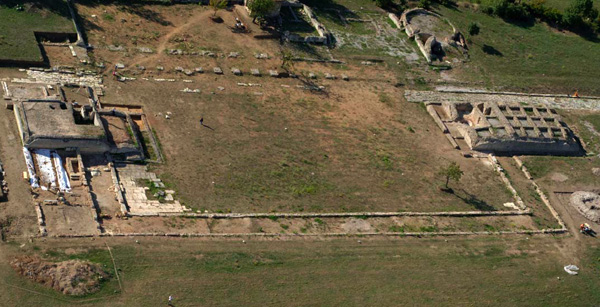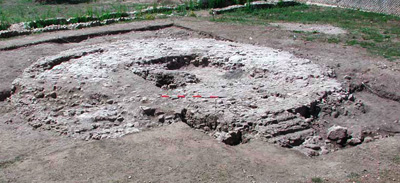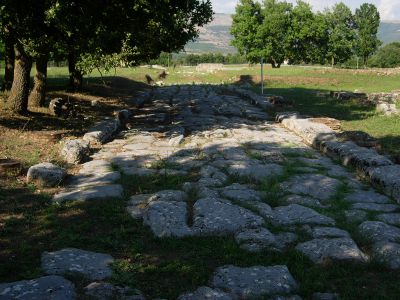Forum area and recent excavationsby Attilio Mastrocinque
The Forum is a key component of Roman cities: in fact is the earth of public life, a large open square which is overlooked by the main administrative, religious and commercial buildings . Grumentum’s Forum since several years hosts the excavations from the University of Verona, in collaboration with the Superintendence of Archaeological Heritage of Basilicata and the Council of Grumento Nova.
Of particular interest is the discovery, in 2006, of a round temple, adjacent to the Forum and the temple D (Capitolium ). The area where is located this structure has acquainted a long continuity of life, and was populated until the Middle and Modern Ages, as evidenced by pottery, coins and remains of a fireplace.
Excavations led by Carmelo Malacrino on the north-west side of the temple C, have permitted to identify a wrought pavement very compact, that perhaps was the most ancient pave of the Forum, dating from the late Hellenistic age, just before sending out Roman colony or during his first phase. The excavations of 2008 have investigated a large part of the podium. The stratigraphy recorded in 2007 was confirmed by new investigations, by Massimo Saracino, which demonstrates that a rough wrought pave preceded the construction of the temple. Above it was set a second paving (completely removed in the Late Antiquity period in the most of the area around the building). Moreover it was identified the replacing of the accessing staircase, not certainly dated, which allowed the raising of the bottom of the stairs itself, probably in conjunction with a trampling pave of Late Antiquity.
The excavations from 2005 to 2009, in the place adjacent to the temple C (Augusteus), on the south side, leaded by Federica Candelato, then continued in the next two years, have identified several stages in the life of the monument, framed between the fourth century B.C. and the fifth century A.C., evident in this sequence of paving: -one of Augustan age, which preserves testimonies of the phase in the construction of the temple, -one at the time of Emperor Tiberius, in the period of inauguration of the temple, -one dated a little after the middle of the first century A.C., around the Flavian age, containing many archaeological finds, -one ostensibly dated at Trajan age, -and finally one of Tetrarchic age. Remarkable was the quantity of finds coming from the various strata, in particular a lot of coins (about 40) that cover a period from the end of the first century B.C. throughout the fourth century A.C., fragments of oil lamps mostly attributable to the first half of the first century B.C. and of African terra sigillata (in almost all areas of excavations). It seems that the work of monumental in the area of the temple C, the oldest in the Forum area, have started in Augustan age, and then completed under Tiberius. Not long after that, was built the colonnade in the south-west side of the square, and afterwards the temple D, the Capitolium. The end of the life of the complex is datable thanks to the testimony of two adults and a child found close to the temple D (Augusteus), on the south side, under two blocks of stone probably coming from the Roman paving of the Forum. The grave, within which there was a coin of a Constantine’s son, enables to date to the second half of fourth century or some time later the end of political life of the urban Forum and the desecration of the temple C.
Behind the back side of the podium is also emerged the final part of a quadrangular building that turns into an almost circular shape, recognized as a fountain. Probably when it was burned to the ground, it was built another one, on the north side of the temple C, of which it’s still possible see the remains. These excavations have also revealed a complex sequence of wrought pave preceding the grave paving of the Forum, dating in Tiberian age or, at the latest, in Claudian age. By Ugo Fusco, were performed excavations close to the surviving parts of the Forum paving, in order to intercept the stratigraphies concerning its life stages. The first arrangement of the square consists of a wrought paving in cobblestones, ceramic fragments and mold, dating in the first half of the first century B.C. During the second half of the first century B.C., this wrought paving has been replaced by a mortar paving, which preceded the creation of the porch stylobate, that cuts it. Afterwards, in Augustan age, was carried out the porch and a new square paving, consisting of a mortar wrought. The existing pavement, constituted by blocks of limestone, has a rough chronology in Tiberian age or shortly later, in synchronization with the reconstruction of the porch, which assumed the appearance of the visible traces which remain nowadays. Probably in this stage is also carried out a structure that can be interpreted as a cistern, or underground tank, functional to the system of water drainage. The excavations in 2009 allows to bring to light two basements placed in front of the temple F (Capitolium ), in the south-east corner, probably designed to support honorary statues.
In conclusion, from the investigations during the mission performed by the University of Verona, it follows that the Forum was equipped by paving more or less in Caesarian age. In Augustan age began the monumental of the area, with the start of work at the temple C, the Augusteus, and the realization of a first portico with columns. The greatest effort in the monumental of the area was due to a project realized in Tiberian age and then completed with the temple D (Capitolium) in Claudian age (at the most in Neronian age). Under Trajan there was another stage of renovation, with the new paving of the decumanus, which also passes through the Forum. The second and the third century don’t record any fervor of activity and didn’t provide us any materials, while a revival, even if in a minor key and without any artistic pretension, there was between Tetrarchic and Constantinian age. In the fourth century should be happened the collapse of the temples and the deterioration of the square pavement. This was followed by the divestments, especially in the fifth century, and the collapse of the porch marked a setback in the public life of the Forum. The recent surveys by Enrico Cirelli and Fabio Saggioro about medieval materials, allowed us to delineate a new reconstruction of the city life, which seems to continue until the eight century with a good business of importing materials. |






 The temple is a
The temple is a  The archaeological survey conducted under the temple D (Capitolium ), by Ugo Fusco, revealed the previous structures, then demolished for the construction of the building around the middle of the first century A.C.
The archaeological survey conducted under the temple D (Capitolium ), by Ugo Fusco, revealed the previous structures, then demolished for the construction of the building around the middle of the first century A.C. The area near the temple C (Augusteus), on the south side, gave us back a rich quantity of materials. It is possible that an earthquake, or another kind of phenomena limited in the time, has broken down the painted
The area near the temple C (Augusteus), on the south side, gave us back a rich quantity of materials. It is possible that an earthquake, or another kind of phenomena limited in the time, has broken down the painted